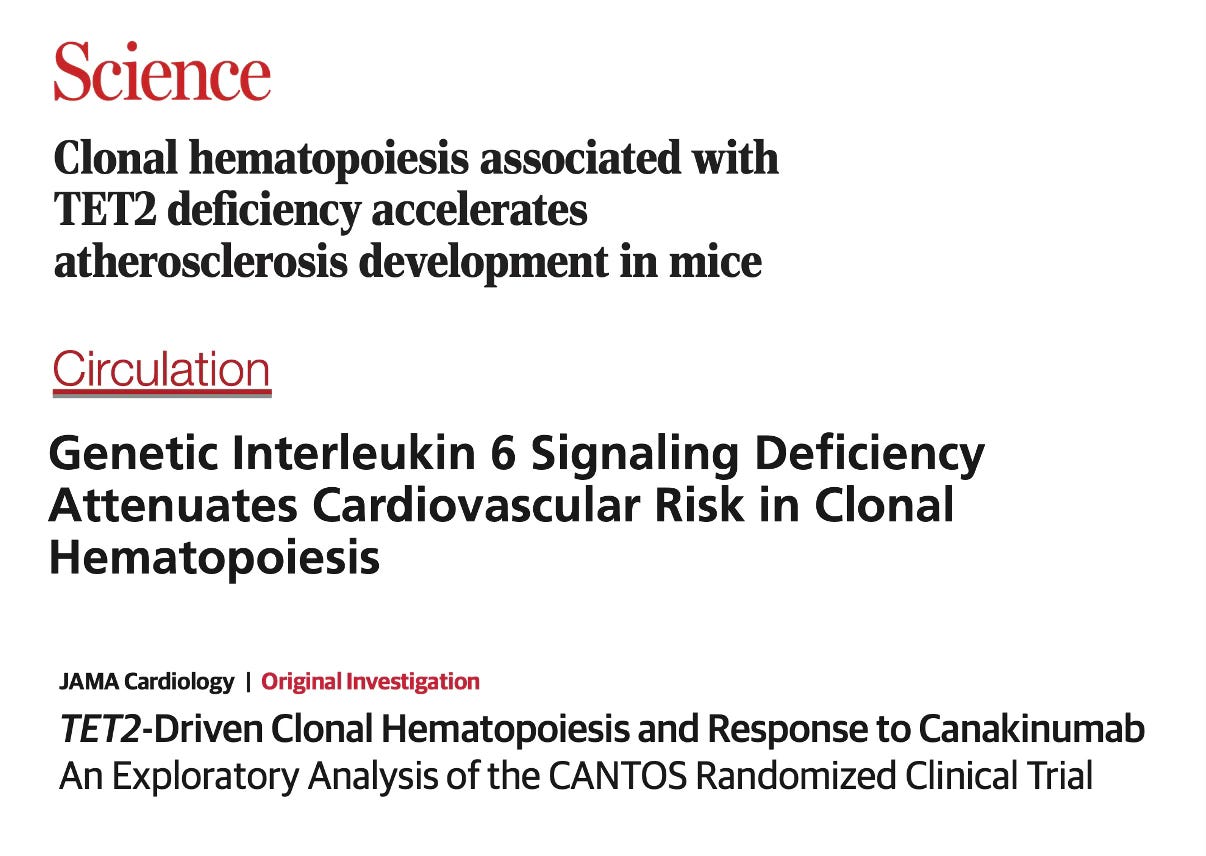Pradeep is a brilliant geneticist and Director of Preventive Cardiology, holds the Paul & Phyllis Fireman Endowed Chair in Vascular Medicine at Mass General Hospital and on faculty at Harvard Medical School and the Broad Institute. His prolific research has been illuminating for the field of improving our approach to reduce the risk of heart disease. That’s especially important because heart disease is the global (and US) #1 killer and is on the increase. We didn’t get into lifestyle factors here since there was so much ground to cover on new tests. drugs, and strategies.
A video snippet of our conversation on ApoB. Full videos of all Ground Truths podcasts can be seen on YouTube here. The audios are also available on Apple and Spotify.
Transcript with links to key publications and audio
Eric Topol (00:06):
Well, welcome to Ground Truths. I'm Eric Topol and with me is Pradeep Natarajan from Harvard. He's Director of Preventative Cardiology at the Mass General Brigham Health System and he has been lighting it up on the field of cardiovascular. We're going to get to lots of different parts of that story and so, Pradeep welcome.
Pradeep Natarajan (00:31):
Thanks Eric, really delighted and honored to be with you and have this discussion.
Eric Topol (00:36):
Well, for years I've been admiring your work and it's just accelerating and so there's so many things to get to. I thought maybe what we'd start off with is you recently wrote a New England Journal piece about two trials, two different drugs that could change the landscape of cardiovascular prevention in the future. I mean, that's one of the themes we're going to get to today is all these different markers and drugs that will change cardiology as we know it now. So maybe you could just give us a skinny on that New England Journal piece.
Two New Lipid Targets With RNA Drugs
Pradeep Natarajan (01:16):
Yeah, yeah, so these two agents, the trials were published at the same time. These phase two clinical trials for plozasiran, which is an siRNA against APOC3 and zodasiran, which is an siRNA against ANGPTL3. The reason why we have medicines against those targets are based on human genetics observations, that individuals with loss of function mutations and either of those genes have reduced lipids. For APOC3, it's reduced triglycerides for ANGPTL3 reduced LDL cholesterol and reduced triglycerides and also individuals that have those loss of function mutations also have lower risk for coronary artery disease. Now that's a very similar parallel to PCSK9. We have successful medicines that treat that target because people have found that carriers of loss of function mutations in PCSK9 lead to lower LDL cholesterol and lower coronary artery disease.
(02:11):
Now that suggests that therapeutic manipulation without significant side effects from the agents themselves for APOC3 and ANGPTL3 would be anticipated to also lower coronary artery disease risk potentially in complementary pathways to PCSK9. The interesting thing with those observations is that they all came from rare loss of function mutations that are enriched in populations of individuals. However, at least for PCSK9, has been demonstrated to have efficacy in large groups of individuals across different communities. So the theme of that piece was really just the need to study diverse populations because those insights are not always predictable about which communities are going to have those loss of function mutations and when you find them, they often have profound insights across much larger groups of individuals.
Eric Topol (03:02):
Well, there's a lot there that we can unpack a bit of it. One of them is the use of small interfering RNAs (siRNA) as drugs. We saw in the field of PCSK9, as you mentioned. First there were monoclonal antibodies directed against this target and then more recently, there’s inclisiran which isn't an RNA play if you will, where you only have to take it twice a year and supposedly it's less expensive and I’m still having trouble in my practice getting patients covered on their insurance even though it's cheaper and much more convenient. But nonetheless, now we're seeing these RNA drugs and maybe you could comment about that part and then also the surprise that perhaps is unexplained is the glucose elevation.
Pradeep Natarajan (03:53):
Yeah, so for medicines and targets that have been discovered through human genetics, those I think are attractive for genetic-based therapies and longer interval dosing for the therapies, which is what siRNAs allow you to do because the individuals that have these perturbations, basically the naturally occurring loss of function mutations, they have these lifelong, so basically have had a one-time therapy and have lived, and so far, at least for these targets, have not had untoward side effects or untoward phenotypic consequences and only reduce lipids and reduce coronary artery disease. And so, instead of taking a pill daily, if we have conviction that that long amount of suppression may be beneficial, then longer interval dosing and not worrying about the pill burden is very attractive specifically for those specific therapeutics. And as you know, people continue to innovate on further prolonging as it relates to PCSK9.
(04:57):
Separately, some folks are also developing pills because many people do feel that there's still a market and comfort for daily pills. Now interestingly for the siRNA for zodasiran at the highest dose, actually for both of them at the highest doses, but particularly for zodasiran, there was an increase in insulin resistance parameters actually as it relates to hyperglycemia and less so as it relates to insulin resistance, that is not predicted based on the human genetics. Individuals with loss of function mutations do not have increased risks in hyperglycemia or type 2 diabetes, so that isolates it related to that specific platform or that specific technology. Now inclisiran, as you'd mentioned, Eric is out there. That's an siRNA against PCSK9 that's made by a different manufacturer. So far, the clinical trials have not shown hyperglycemia or type 2 diabetes as it relates inclisiran, so it may be related to the specific siRNAs that are used for those targets. That does merit further consideration. Now, the doses that the manufacturers do plan to use in the phase three clinical trials are at lower doses where there was not an increase in hyperglycemia, but that does merit further investigation to really understand why that's the case. Is that an expected generalized effect for siRNAs? Is it related to siRNAs for this specific target or is it just related to the platform used for these two agents which are made by the same manufacturer?
Eric Topol (06:27):
Right, and I think the fact that it's a mystery is intriguing at the least, and it may not come up at the doses that are used in the trials, but the fact that it did crop up at high doses is unexpected. Now that is part of a much bigger story is that up until now our armamentarium has been statins and ezetimibe to treat lipids, but it's rapidly expanding Lp(a), which for decades as a cardiologist we had nothing to offer. There may even be drugs to be able to lower people who are at high risk with high Lp(a). Maybe you could discuss that.
What About Lp(a)?
Pradeep Natarajan (07:13):
Yeah, I mean, Eric, as you know, Lp(a) has been described as a cardiovascular disease risk factors for quite so many years and there are assays to detect lipoprotein(a) elevation and have been in widespread clinical practice increasing widespread clinical practice, but we don't yet have approved therapies. However, there is an abundance of literature preclinical data that suggests that it likely is a causal factor, meaning that if you lower lipoprotein(a) when elevated, you would reduce the risk related to lipoprotein(a). And a lot of this comes from similar human genetic studies. The major challenge of just relating a biomarker to an outcome is there are many different reasons why a biomarker might be elevated, and so if you detect a signal that correlates a biomarker, a concentration to a clinical outcome, it could be related to that biomarker, but it could be to the other reasons that the biomarker is elevated and sometimes it relates to the outcome itself.
(08:10):
Now human genetics is very attractive because if you find alleles that strongly relate to that exposure, you can test those alleles themselves with the clinical outcome. Now the allele assignment is established at birth. No other factor is going to change that assignment after conception, and so that provides a robust, strong causal test for that potential exposure in clinical outcome. Now, lipoprotein(a) is unique in that it is highly heritable and so there are lots of different alleles that relate to lipoprotein(a) and so in a well powered analysis can actually test the lipoprotein(a) SNPs with the clinical outcomes and similar to how there is a biomarker association with incident myocardial infarction and incident stroke, the SNPs related to lipoprotein(a) show the same. That is among the evidence that strongly supports that this might be causal. Now, fast forward to many years later, we have at least three phase three randomized clinical trials testing agents that have been shown to be very potent at lowering lipoprotein(a) that in the coming years we will know if that hypothesis is true. Importantly, we will have to understand what are the potential side effects of these medicines. There are antisense oligonucleotides and siRNAs that are primarily in investigation. Again, this is an example where there's a strong genetic observation, and so these genetic based longer interval dosing therapies may be attractive, but side effects will be a key thing as well too. Those things hard to anticipate really can anticipate based on the human genetics for off target effects, for example.
(09:52):
It's clearly a risk signal and hopefully in the near future we're going to have specific therapies.
Eric Topol (09:57):
Yeah, you did a great job of explaining Mendelian randomization and the fact the power of genetics, which we're going to get into deeper shortly, but the other point is that do you expect now that there's these multiple drugs that lower Lp(a) efficiently, would that be enough to get approval or will it have to be trials to demonstrate improved cardiovascular outcomes?
Pradeep Natarajan (10:24):
There is a great regulatory path at FDA for approval just for LDL cholesterol lowering and inclisiran is on the market and the phase three outcomes data has not yet been reported because there is a wide appreciation that LDL cholesterol lowering is a pretty good surrogate for cardiovascular disease risk lowering. The label will be restricted to LDL cholesterol lowering and then if demonstrated to have clinical outcomes, the label could be expanded. For other biomarkers including lipoprotein(a), even though we have strong conviction that it is likely a causal factor there hasn't met the bar yet to get approval just based on lipoprotein(a) lowering, and so we would need to see the outcomes effects and then we would also need to understand side effects. There is a body of literature of side effects for other therapies that have targeted using antisense oligonucleotides. We talked about potential side effects from some siRNA platforms and sometimes those effects could overtake potential benefits, so that really needs to be assessed and there is a literature and other examples.
(11:31):
The other thing I do want to note related to lipoprotein(a) is that the human genetics are modeled based on lifelong perturbations, really hard to understand what the effects are, how great of an effect there might be in different contexts, particularly when introduced in middle age. There's a lot of discussion about how high lipoprotein(a) should be to deliver these therapies because the conventional teaching is that one in five individuals has high lipoprotein(a), and that's basically greater than 75 nanomoles per liter. However, some studies some human genetic studies to say if you want to get an effect that is similar to the LDL cholesterol lowering medicines on the market, you need to start with actually higher lipoprotein(a) because you need larger amounts of lipoprotein(a) lowering. Those are studies and approaches that haven't been well validated. We don't know if that's a valid approach because that's modeling based on this sort of lifelong effect. So I'm very curious to see what the overall effect will be because to get approval, I think you need to demonstrate safety and efficacy, but most importantly, these manufacturers and we as clinicians are trying to find viable therapies in the market that it won't be hard for us to get approval because hopefully the clinical trial will have said this is the context where it works. It works really well and it works really well on top of the existing therapies, so there are multiple hurdles to actually getting it directly to our patients.
How Low Do You Go with LDL Cholesterol?
Eric Topol (13:02):
Yeah, no question about that. I'm glad you've emphasized that. Just as you've emphasized the incredible lessons from the genetics of people that have helped guide this renaissance to better drugs to prevent cardiovascular disease. LDL, which is perhaps the most impressive surrogate in medicine, a lab test that you already touched on, one of the biggest questions is how low do you go? That is Eugene Braunwald, who we all know and love. They're in Boston. The last time I got together with him, he was getting his LDL down to close to zero with various tactics that might be extreme. But before we leave these markers, you're running preventive cardiology at man's greatest hospital. Could you tell us what is your recipe for how aggressive do you go with LDL?
Pradeep Natarajan (14:04):
Yeah, so when I talk to patients where we're newly getting lipid lowering therapies on, especially because many people don't have a readout of abnormal LDL cholesterol when we're prescribing these medicines, it's just giving them a sense of what we think an optimal LDL cholesterol might be. And a lot of this is based on just empirical observations. So one, the average LDL cholesterol in the modern human is about 100 to 110 mg/dL. However, if you look at contemporary hunter gatherers and non-human primates, their average LDL is about 40 to 50 and newborn babies have an LDL cholesterol of about 30. And the reason why people keep making LDL cholesterol lowering medicines because as you stack on therapies, cardiovascular disease events continue to reduce including down to these very low LDL cholesterol values. So the population mean for LDL cholesterol is high and everybody likely has hypercholesterolemia, and that's because over the last 10,000 years how we live our lives is so dramatically different and there has not been substantial evolution over that time to change many of these features related to metabolism.
(15:16):
And so, to achieve those really low LDL cholesterol values in today's society is almost impossible without pharmacotherapies. You could say, okay, maybe everybody should be on pharmacotherapies, and I think if you did that, you probably would reduce a lot of events. You'll also be treating a lot of individuals who likely would not get events. Cardiovascular disease is the leading killer, but there are many things that people suffer from and most of the times it still is not cardiovascular disease. So our practice is still rooted in better identifying the individuals who are at risk for cardiovascular disease. And so, far we target our therapies primarily in those who have already developed cardiovascular disease. Maybe we'll talk about better identifying those at risk, but for those individuals it makes lots of sense to get it as low as possible. And the field has continued to move to lower targets.
(16:07):
One, because we've all recognized, at least based on these empirical observations that lower is better. But now increasingly we have a lot of therapies to actually get there, and my hope is that with more and more options and the market forces that influence that the cost perspective will make sense as we continue to develop more. As an aside, related aside is if you look at the last cholesterol guidelines, this is 2018 in the US this is the first time PCSK9 inhibitors were introduced in the guidelines and all throughout that there was discussions of cost. There are a lot of concerns from the field that PCSK9 inhibitors would bankrupt the system because so many people were on statins. And you look at the prior one that was in 2013 and cost was mentioned once it’s just the cost effectiveness of statins. So I think the field has that overall concern.
(17:01):
However, over time we've gotten comfortable with lower targets, there are more medicines and I think some of this competition hopefully will drive down some of the costs, but also the overall appreciation of the science related to LDL. So long-winded way of saying this is kind of the things that we discussed just to give reassurance that we can go to low LDL cholesterol values and that it's safe and then we think also very effective. Nobody knows what the lower limit is, whether zero is appropriate or not. We know that glucose can get too low. We know that blood pressure can be too low. We don't know yet that limit for LDL cholesterol. I mean increasingly with these trials we'll see it going down really low and then we'll better appreciate and understand, so we'll see 40 is probably the right range.
Eric Topol (17:49):
40, you said? Yeah, okay, I'll buy that. Of course, the other thing that we do know is that if you push to the highest dose statins to get there, you might in some people start to see the hyperglycemia issue, which is still not fully understood and whether that is, I mean it's not desirable, but whether or not it is an issue, I guess it's still out there dangling. Now the other thing that since we're on LDL, we covered Lp(a), PCSK9, the siRNA, is ApoB. Do you measure ApoB in all your patients? Should that be the norm?
Measuring ApoB
Pradeep Natarajan (18:32):
Yeah, so ApoB is another blood test. In the standard lipid panel, you get four things. What's measured is cholesterol and triglycerides, they're the lipids insoluble in blood to get to the different tissues that get packaged in lipoprotein molecules which will have the cholesterol, triglycerides and some other lipids and proteins. And so, they all have different names as you know, right? Low density lipoprotein, high density lipoprotein and some others. But also in the lipid panel you get the HDL cholesterol, the amount of cholesterol in an HDL particle, and then most labs will calculate LDL cholesterol and LDL cholesterol has a nice relationship with cardiovascular disease. You lower it with statins and others. Lower risk for cardiovascular disease, turns out a unifying feature of all of these atherogenic lipoproteins, all these lipoproteins that are measured and unmeasured that relate to cardiovascular disease, including lipoprotein(a), they all have an additional protein called ApoB. And ApoB, at least as it relates to LDL is a pretty good surrogate of the number of LDL particles.
(19:37):
Turns out that that is a bit better at the population level at predicting cardiovascular disease beyond LDL cholesterol itself. And where it can be particularly helpful is that there are some patients out there that have an unexpected ratio between ApoB and LDL. In general, the ratio between LDL cholesterol and ApoB is about 1.1 and most people will have that rough ratio. I verify that that is the expected, and then if that is the expected, then really there is no role to follow ApoB. However, primarily the patients that have features related to insulin resistance have obesity. They may often have adequate looking LDL cholesterols, but their ApoB is higher. They have more circulating LDL particles relative to the total amount of LDL cholesterol, so smaller particles themselves. However, the total number of particles may actually be too high for them.
(20:34):
And so, even if the LDL cholesterol is at target, if the ApoB is higher, then you need to reduce. So usually the times that I just kind of verify that I'm at appropriate target is I check the LDL cholesterol, if that looks good, verify with the ApoB because of this ratio, the ApoB target should be about 10% lower. So if we're aiming for about 40, that's like 36, so relatively similar, and if it's there, I'm good. If it's not and it's higher, then obviously increase the LDL cholesterol lowering medicines because lower the ApoB and then follow the ApoB with the lipids going forward. The European Society of Cardiology has more emphasis on measuring ApoB, that is not as strong in the US guidelines, but there are many folks in the field, preventive cardiologists and others that are advocating for the increasing use of ApoB because I think there are many folks that are not getting to the appropriate targets because we are not measuring ApoB.
Why Aren’t We Measuring and Treating Inflammation?
Eric Topol (21:37):
Yeah, I think you reviewed it so well. The problem here is it could be part of the standard lipid panel, it would make this easy, but what you've done is a prudent way of selecting out people who it becomes more important to measure and moderate subsequently. Now this gets us to the fact that we're lipid centric and we don't pay homage to inflammation. So I wrote a recent Substack on the big miss on inflammation, and here you get into things like the monoclonal antibody to interleukin-6, the trial that CANTOS that showed significant reduction in cardiovascular events and fatal cancers by the way. And then you get into these colchicine trials two pretty good size randomized trials, and here the entry was coronary disease with a high C-reactive protein. Now somehow or other we abandon measuring CRP or other inflammatory markers, and both of us have had patients who have low LDLs but have heart attacks or significant coronary disease. So why don't we embrace inflammation? Why don't we measure it? Why don't we have better markers? Why is this just sitting there where we could do so much better? Even agents that are basically cost pennies like colchicine at low doses, not having to use a proprietary version could be helpful. What are your thoughts about us upgrading our prevention with inflammation markers?
Pradeep Natarajan (23:22):
Yeah, I mean, Eric, there is an urgent need to address these other pathways. I say urgent need because heart disease has the dubious distinction of being the leading killer in the US and then over the last 20 years, the leading killer in the world as it takes over non-communicable diseases. And really since the early 1900s, there has been a focus on developing pharmacotherapies and approaches to address the traditional modifiable cardiovascular disease risk factors. That has done tremendous good, but still the curves are largely flattening out. But in the US and in many parts of the world, the deaths attributable to cardiovascular disease are starting to tick up, and that means there are many additional pathways, many of them that we have well recognized including inflammation. More recently, Lp(a) that are likely important for cardiovascular disease, for inflammation, as you have highlighted, has been validated in randomized controlled trials.
(24:18):
Really the key trial that has been more most specific is one on Canakinumab in the CANTOS trial IL-1β monoclonal antibody secondary prevention, so cardiovascular disease plus high C-reactive protein, about a 15% reduction in cardiovascular disease and also improvement in cancer related outcomes. Major issues, a couple of issues. One was increased risk for severe infections, and the other one is almost pragmatic or practical is that that medicine was on the market at a very high price point for rare autoinflammatory conditions. It still is. And so, to have for a broader indication like cardiovascular disease prevention would not make sense at that price point. And the manufacturer tried to go to the FDA and focus on the group that only had C-reactive protein lowering, but that's obviously like a backwards endpoint. How would you know that before you release the medicine? So that never made it to a broader indication.
(25:14):
However, that stuck a flag in the broader validation of that specific pathway in cardiovascular disease. That pathway has direct relevance to C-reactive protein. C-reactive protein is kind of a readout of that pathway that starts from the NLRP3 inflammasome, which then activates IL-1β and IL-6. C-reactive protein we think is just a non causal readout, but is a reliable test of many of these features and that's debatable. There may be other things like measuring IL-6, for example. So given that there is actually substantial ongoing drug development in that pathway, there are a handful of companies with NLRP3 inflammasome inhibitors, but small molecules that you can take as pills. There is a monoclonal antibody against IL-6 that's in development ziltivekimab that's directed at patients with chronic kidney disease who have lots of cardiovascular disease events despite addressing modifiable risk factors where inflammatory markers are through the roof.
(26:16):
But then you would also highlighted one anti-inflammatory that's out there that's pennies on the dollar, that's colchicine. Colchicine is believed to influence cardiovascular disease by inhibiting NLRP3, I say believed to. It does a lot of things. It is an old medicine, but empirically has been shown in at least two randomized controlled trials patients with coronary artery disease, actually they didn't measure C-reactive protein in the inclusion for these, but in those populations we did reduce major adverse cardiovascular disease events. The one thing that does give me pause with colchicine is that there is this odd signal for increased non-cardiovascular death. Nobody understands if that's real, if that's a fluke. The FDA just approved last year low dose colchicine, colchicine at 0.5 milligrams for secondary prevention given the overwhelming efficacy. Hasn’t yet made it into prevention guidelines, but I think that's one part that does give me a little bit pause. I do really think about it particularly for patients who have had recurrent events. The people who market the medicine and do research do remind us that C-reactive protein was not required in the inclusion, but nobody has done that secondary assessment to see if measuring C-reactive protein would be helpful in identifying the beneficial patients. But I think there still could be more work done on better identifying who would benefit from colchicine because it's an available and cheap medicine. But I'm excited that there is a lot of development in this inflammation area.
Eric Topol (27:48):
Yeah, well, the development sounds great. It's probably some years away. Do you use colchicine in your practice?
Pradeep Natarajan (27:56):
I do. Again, for those folks who have had recurrent events, even though C-reactive protein isn't there, it does make me feel like I'm treating inflammation. If C-reactive protein is elevated and then I use it for those patients, if it's not elevated, it's a much harder sell from my standpoint, from the patient standpoint. At the lower dose for colchicine, people generally are okay as far as side effects. The manufacturer has it at 0.5 milligrams, which is technically not pennies on the dollar. That's not generic. The 0.6 milligrams is generic and they claim that there is less side effects at the 0.5 milligrams. So technically 0.6 milligrams is off label. So it is what it is.
CHIP and Defining High Risk People for CV Disease
Eric Topol (28:40):
It's a lot more practical, that's for sure. Now, before I leave that, I just want to mention when I reviewed the IL-1β trial, you mentioned the CANTOS trial and also the colchicine data. The numbers of absolute increases for infection with the antibody or the cancers with the colchicine are really small. So I mean the benefit was overriding, but I certainly agree with your concern that there's some things we don't understand there that need to be probed more. Now, one of the other themes, well before one other marker that before we get to polygenic risk scores, which is center stage here, defining high risk people. We've talked a lot about the conventional things and some of the newer ways, but you've been one of the leaders of study of clonal hematopoiesis of indeterminate potential known as CHIP. CHIP, not the chips set in your computer, but CHIP. And basically this is stem cell mutations that increase in people as we age and become exceptionally common with different mutations that account in these clones. So maybe you can tell us about CHIP and what I don't understand is that it has tremendous correlation association with cardiovascular outcomes adverse as well as other system outcomes, and we don't measure it and we could measure it. So please take us through what the hell is wrong there.
Pradeep Natarajan (30:14):
Yeah, I mean this is really exciting. I mean I'm a little bit biased, but this is observations that have been made only really over the last decade, but accelerating research. And this has been enabled by advances in genomic technologies. So about 10 years or plus ago, really getting into the early days of population-based next generation sequencing, primarily whole exome sequencing. And most of the DNA that we collect to do these population-based analyses come from the blood, red blood cells are anucleate, so they're coming from white blood cells. And so, at that time, primarily interrogating what is the germline genetic basis for coronary artery disease and early onset myocardial infarction. At the same time, colleagues at the Broad Institute were noticing that there are many additional features that you can get from the blood-based DNA that was being processed by the whole exome data. And there were actually three different groups that converged on that all in Boston that converged on the same observation that many well-established cancer causing mutations.
(31:19):
So mutations that are observed in cancers that have been described to drive the cancers themselves were being observed in these large population-based data sets that we were all generating to understand the relationship between loss of function mutations in cardiovascular disease. That's basically the intention of those data sets for being generated for other things. Strong correlation with age, but it was very common among individuals greater than 70; 10% of them would have these mutations and is very common because blood cancer is extremely, it's still pretty rare in the population. So to say 10% of people had cancer causing driver mutations but didn't have cancer, was much higher than anyone would've otherwise expected. In 2014, there were basically three main papers that described that, and they also observed that there is a greater risk of death. You'd say, okay, this is a precancerous lesion, so they're probably dying of cancer.
(32:17):
But as I said, the absolute incidence rate for blood cancer is really low and there's a relative increase for about tenfold, but pretty small as it relates to what could be related to death. And in one of the studies we did some exploratory analysis that suggested maybe it's actually the most common cause of death and that was cardiovascular disease. And so, a few years later we published a study that really in depth really looked at a bunch of different data sets that were ascertained to really understand the relationship between these mutations, these cancer causing mutations in cardiovascular disease, so observed it in enrichment and older individuals that had these mutations, CHIP mutations, younger individuals who had early onset MI as well too, and then also look prospectively and showed that it related to incident coronary artery disease. Now the major challenge for this kind of analysis as it relates to the germline genetic analysis is prevalence changes over time.
(33:15):
There are many things that could influence the presence of clonal hematopoiesis. Age is a key enriching factor and age is the best predictor for cardiovascular disease. So really important. So then we modeled it in mice. It was actually a parallel effort at Boston University (BU) that was doing the same thing really based on the 2014 studies. And so, at the same time we also observed when you modeled this in mice, you basically perturb introduce loss of function mutations in the bone marrow for these mice to recapitulate these driver mutations and those mice also have a greater burden of atherosclerosis. And Eric, you highlighted inflammation because basically the phenotype of these cells are hyper inflamed cells. Interestingly, C-reactive protein is only modestly elevated. So C-reactive protein is not fully capturing this, but many of the cytokines IL-1β, IL-6, they're all upregulated in mice and in humans when measured as well.
(34:11):
Now there've been a few key studies that have been really exciting about using anti-inflammatories in this pathway to address CHIP associated cardiovascular disease. So one that effort that I said in BU because they saw these cytokines increased, we already know that these cytokines have relationship with atherosclerosis. So they gave an NLRP3 inflammasome inhibitor to the mice and they showed that the mice with or without CHIP had a reduction in atherosclerosis, but there was a substantial delta among the mice that are modeled as having CHIP. Now, the investigators in CANTOS, the manufacturers, they actually went back and they survey where they had DNA in the CANTOS trial. They measured CHIP and particularly TET2 CHIP, which is the one that has the strongest signal for atherosclerosis. As I said, overall about 15% reduction in the primary outcome in CANTOS. Among the individuals who had TET2 CHIP, it was a 64% reduction in event.
(35:08):
I mean you don't see those in atherosclerosis related trials. Now this has the caveat of it being secondary post hoc exploratory, the two levels of evidence. And so, then we took a Mendelian randomization approach. Serendipitously, just so happens there is a coding mutation in the IL-6 receptor, a missense mutation that in 2012 was described that if you had this mutation, about 40% of people have it, you have a 5%, but statistically significant reduction in coronary artery disease. So we very simply said, if the pathway of this NLRP3 inflammasome, which includes IL-6, if you have decreased signaling in that pathway, might you have an even greater benefit from having that mutation if you had CHIP versus those who didn't have CHIP. So we looked in the UK Biobank, those who didn't have CHIP 5% reduction, who had that IL-6 receptor mutation, and then those who did have CHIP, if they had that mutation, it was about a 60% reduction in cardiovascular disease.
(36:12):
Again, three different lines of evidence that really show that this pathway has relevance in the general population, but the people who actually might benefit the most are those with CHIP. And I think as we get more and more data sets, we find that not all of the CHIP mutations are the same as it relates to cardiovascular disease risk. It does hone in on these key subsets like TET2 and JAK2, but this is pretty cool as a preventive cardiologist, new potential modifiable risk factor, but now it's almost like an oncologic paradigm that is being applied to coronary artery disease where we have specific driver mutations and then we're tailoring our therapies to those specific biological drivers for coronary artery disease. Hopefully, I did that justice. There's a lot there.
Why Don’t We Measure CHIP?
Eric Topol (36:57):
Well, actually, it's phenomenal how you've explained that, but I do want to review for our listeners or readers that prior to this point in our conversation, we were talking about germline mutations, the ones you're born with. With CHIP, we're talking about acquired somatic mutations, and these are our blood stem cells. And what is befuddling to me is that with all the data that you and others, you especially have been publishing and how easy it would be to measure this. I mean, we've seen that you can get it from sequencing no less other means. Why we don't measure this? I mean, why are we turning a blind eye to CHIP? I just don't get it. And we keep calling it of indeterminate potential, not indeterminate. It's definite potential.
Pradeep Natarajan (37:51):
Yeah, no, I think these are just overly cautious terms from the scientists. Lots of people have CHIP, a lot of people don't have clinical outcomes. And so, I think from the lens of a practicing hematologists that provide some reassurance on the spectrum for acquired mutation all the way over to leukemia, that is where it comes from. I don't love the acronym as well because every subfield in biomedicine has its own CHIP, so there's obviously lots of confusion there. CH or clinical hematopoiesis is often what I go, but I think continuing to be specific on these mutations. Now the question is why measure? Why aren't we measuring it? So there are some clinical assays out there. Now when patients get evaluated for cytopenias [low cell counts], there are next generation sequencing tests that look for these mutations in the process for evaluation. Now, technically by definition, CHIP means the presence of these driver mutations that have expanded because it's detectable by these assays, not a one-off cell because it can only be detected if it's in a number of cells.
(38:55):
So there has been some expansion, but there are no CBC abnormalities. Now, if there's a CBC abnormality and you see a CHIP mutation that's technically considered CCUS or clonal cytopenia of unknown significance, sometimes what is detected is myelodysplastic syndrome. In those scenarios still there is a cardiovascular disease signal, and so many of our patients who are seen in the cancer center who are being evaluated for these CBC abnormalities will be detected to have these mutations. They will have undergone some risk stratification to see what the malignancy potential is. Still pretty low for many of those individuals. And so, the major driver of health outcomes for this finding may be cardiovascular. So those patients then get referred to our program. Dana-Farber also has a similar program, and then my colleague Peter Libby at the Brigham often sees those patients as well. Now for prospective screening, so far, an insurance basically is who's going to pay for it.
(39:51):
So an insurance provider is not deemed that appropriate yet. You do need the prospective clinical trials because the medicines that we're talking about may have side effects as well too. And what is the yield? What is the diagnostic yield? Will there actually be a large effect estimate? But there has been more and more innovation, at least on the assay and the cost part of the assay because these initial studies, we've been using whole exome sequencing, which is continuing to come down, but is not a widely routine clinical test yet. And also because as you highlighted, these are acquired mutations. A single test is not necessarily one and done. This may be something that does require surveillance for particular high risk individuals. And we've described some risk factors for the prevalence of CHIP. So surveillance may be required, but because there are about 10 genes that are primarily implicated in CHIP, that can substantially decrease the cost of it. The cost for DNA extraction is going down, and so there are research tests that are kind of in the $10 to $20 range right now for CHIP. And if flipped over to the clinical side will also be reasonably low cost. And so, for the paradigm for clinical implementation, that cost part is necessary.
Eric Topol (41:10):
I don't know the $10 or $20 ones. Are there any I could order on patients that I'm worried about?
Pradeep Natarajan (41:17):
Not yet clinical. However, there is a company that makes the reagents for at least the cores that are developing this. They are commercializing that test so that many other cores, research cores can develop it. I think it's in short order that clinical labs will adopt it as well too.
Eric Topol (41:36):
That's great.
Pradeep Natarajan (41:37):
I will keep you apprised.
What About Polygenic Risk Scores?
Eric Topol (41:39):
I think that's really good news because like I said, we're so darn lipid centric and we have to start to respect the body of data, the knowledge that you and others have built about CHIP. Now speaking of another one that drives me nuts is polygenic risk score (PRS) for about a decade, I've been saying we have coronary disease for most people is a polygenic trait. It's not just a familial hypercholesterolemia. And we progressively have gotten better and better of the hundreds of single variants that collectively without a parental history will be and independently predict who is at double, triple or whatever risk of getting heart disease, whereby you could then guide your statins at higher aggressive or pick a statin, use one or even go beyond that as we've been talking about. But we don't use that in practice, which is just incredible because it's can be done cheap.
(42:45):
You can get it through whether it's 23andMe or now many other entities. We have an app, MyGeneRank where we can process that Scripss does for free. And only recently, Mass General was the first to implement that in your patient population, and I'm sure you were a driver of that. What is the reluctance about using this as an orthogonal, if you will, separate way to assess a person's risk for heart disease? And we know validated very solidly about being aggressive about lipid lowering when you know this person's in the highest 5% polygenic risk score. Are we just deadheads in this field or what?
Pradeep Natarajan (43:30):
Yeah, I mean Eric, as you know, lots of inertia in medicine, but this one I think has a potential to make a large impact. Like CHIP mutations, I said news is about 10% in individuals greater than 70. The prospect here is to identify the risk much earlier in life because I think there is a very good argument that we're undertreating high risk individuals early on because we don't know how to identify them. As you highlighted, Dr. Braunwald about LDL cholesterol. The other part of that paradigm is LDL cholesterol lowering and the duration. And as we said, everybody would benefit from really low LDL cholesterol, but again, you might overtreat that if you just give that to everybody. But if you can better identify the folks very early in life, there is a low cost, low risk therapy, at least related to statins that you could have a profound benefit from the ones who have a greater conviction will have future risk for cardiovascular disease.
(44:21):
You highlighted the family history, and the family history has given the field of clues that genetics play a role. But as the genome-wide association studies have gotten larger, the polygenic risk scores have gotten better. We know that family history is imperfect. There are many reasons why a family member who is at risk may or may not have developed cardiovascular disease. A polygenic risk score will give a single number that will estimate the contribution of genetics to cardiovascular disease. And the thing that is really fascinating to me, which is I think some of a clinical implementation challenge is that the alleles for an individual are fixed. The genotyping is very cheap. That continues to be extremely cheap to do this test. But the weights and the interpretation of what the effects should be for each of the SNPs are continually being refined over time.
(45:18):
And so, given the exact same SNPs in the population, the ability to better predict cardiovascular diseases getting better. And so, you have things that get reported in the literature, but literally three years later that gets outdated and those hypotheses need to be reassessed. Today, I'll say we have a great relative to other things, but we have a great polygenic risk score was just reported last year that if you compare it to familial hypercholesterolemia, which has a diagnostic yield of about 1 in 300 individuals, but readily detectable by severe hypercholesterolemia that has about threefold risk for cardiovascular disease. By polygenic risk score, you can find 1 in 5 individuals with that same risk. Obviously you go higher than that, it'll be even higher risk related to that. And that is noble information very early in life. And most people develop risk factors later in life. It is happening earlier, but generally not in the 30s, 40s where there's an opportunity to make a substantial impact on the curve related to cardiovascular disease.
(46:25):
But there is a lot of momentum there. Lots of interest from NIH and others. The major challenge is though the US healthcare system is really not well set up to prevention, as you know, we practice healthcare after patient's developed disease and prevent the complications related to progression. The stakeholder incentives beyond the patient themselves are less well aligned. We've talked a lot here today about payers, but we don't have a single payer healthcare system. And patients at different times of their lives will have different insurers. They'll start early in life with their parents, their first employer, they'll move on to the next job and then ultimately Medicare. There's no entity beyond yourself that really cares about your longevity basically from the beginning and your overall wellness. That tension has been a major challenge in just driving the incentives and the push towards polygenic risk scores. But there are some innovative approaches like MassMutual Life Insurance actually did a pilot on polygenic risk scoring.
(47:33):
They're in the business of better understanding longevity. They get that this is important data. Major challenges, there are federal protections against non-discrimination in the workplace, health insurance, not necessarily life insurance. So I think that there are lots of things that have to be worked out. Everybody recognizes that this is important, but we really have to have all the incentives aligned for this to happen at a system-wide level in the US. So there's actually lots of investment in countries that have more nationalized healthcare systems, lots of development in clinical trials in the UK, for example. So it's possible that we in the US will not be the lead in that kind of evidence generation, but maybe we'll get there.
The GLP-1 Drugs
Eric Topol (48:16):
Yeah, it's frustrating though, Pradeep, because this has been incubating for some time and now we have multi ancestry, polygenic risk scores, particularly for heart disease and we're not using it, and it's not in my view, in the patient's best interest just because of these obstacles that you're mentioning, particularly here in the US. Well, the other thing I want to just get at with you today is the drugs that we were using for diabetes now blossoming for lots of other indications, particularly the glucagon-like peptide 1 (GLP-1) drugs. This has come onto the scene in recent years, not just obviously for obesity, but it's anti-inflammatory effects as we're learning, mediated not just through the brain but also T cells and having extraordinary impact in heart disease for people with obesity and also with those who have heart failure, about half of heart failure for preserved ejection fraction. So recently you and your colleagues recently published a paper with this signal of optic neuropathy. It was almost seven eightfold increase in a population. First, I wanted to get your sense about GLP-1. We're also going to get into the SGLT2 for a moment as well, but how do you use GLP-1? What's your prognosis for this drug class going forward?
Pradeep Natarajan (49:55):
As it relates to the paper, I can't claim credit as one of my former students who is now Mass Eye and Ear resident who participated, but we can talk about that. There's obviously some challenges for mining real world data, but this was related to anecdotes that they were observing at Mass Eye and Ear and then studied and observed an enrichment. In general though, I feel like every week I'm reading a new clinical trial about a new clinical outcome benefit as it relates to GLP-1 receptor agonists. This is kind of one thing that stands out that could be interrogated in these other clinical trials. So I would have that caveat before being cautious about ocular complications. But the data has been overwhelmingly beneficial, I think, because at minimum, obesity and inflammation are relayed to myriad of consequences, and I'm really excited that we have therapies that can address obesity that are safe.
(50:52):
There's a legacy of unsafe medicines for obesity, especially related to cardiovascular disease. So the fact that we have medicines that are safe and effective for lowering weight that also have real strong effects on clinical outcomes is tremendous. We in cardiology are increasingly using a range of diabetes medicines, including GLP-1 receptor agonists and SGLT2 inhibitors. I think that is also the secular changes of what influences cardiovascular disease over time. I talked about over the last 10 years or so with this increase in deaths attributable to cardiovascular disease. If you look at the influences of traditional clinical risk factors today, many of them have decreased in importance because when abnormal, we recognize them, in general we modify them when recognized. And so, many of the things that are unaddressed, especially the features related to insulin resistance, obesity, they start rising in importance. And so, there is a dramatic potential for these kinds of therapies in reducing the residual risks that we see related to cardiovascular disease. So I'm enthusiastic and excited. I think a lot more biology that needs to be understood of how much of this is being influenced specifically through this pathway versus a very effective weight loss medicine. But also interesting to see the insights on how the effect centrally on appetite suppression has profound influences on weight loss as well too. And hopefully that will lead to more innovations in weight management.
The SGLT-2 Drugs
Eric Topol (52:25):
And likewise, perhaps not getting near as much play, but when it came on the cardiovascular scene that an anti-diabetic drug SGLT2 was improving survival, that was big, and we still don't know why. I mean, there's some ideas that it might be a senolytic drug unknowingly, but this has become a big part of practice of cardiology in patients with diabetes or with preserved ejection fraction heart failure. Is that a fair summary for that drug?
Pradeep Natarajan (53:00):
Yeah, I totally agree. I mean, as there has been increased recognition for heart failure preserved ejection fraction, it has been almost disheartening over the last several years that we have not had very specific effective therapies to treat that condition. Now, it is a tremendous boon that we do have medicines interestingly focused on metabolism that are very helpful in that condition for heart failure with preserved ejection fraction. But there is still much more to be understood as far as that condition. I mean, the major challenge with heart failure, as you know, especially with heart failure preserved ejection fraction, it likely is a mix of a wide variety of different etiologies. So in parallel with developing effective therapies that get at some aspect is really understanding what are the individual drivers and then targeting those specific individual drivers. That requires a lot of unbiased discovery work and further profiling to be done. So lot more innovation, but relative to heart failure itself, it is not had widespread recognition as heart failure reduced ejection fraction. So much more to innovate on, for sure.
Eric Topol (54:07):
Right, right. Yeah, I am stunned by the recent progress in cardiovascular medicine. You have been center stage with a lot of it, and we've had a chance to review so much. And speaking of genetics, I wanted to just get a little insight because I recently came across the fact that your mother here at the City of Hope in Southern California is another famous researcher. And is that, I don't know what chromosome that is on regarding parental transmission of leading research. Maybe you can tell me about that.
Pradeep Natarajan (54:41):
Yeah, I mean, I guess it is a heritable trait when a parent has one profession that there is a higher likelihood that the offspring will have something similar. So both of my parents are PhDs, nonphysicians. There is a diabetes department at the City of Hope, so she's the chair of that department. So very active. We do overlap in some circles because she does investigate both vascular complications and renal complications. And then sometimes will ask my advice on some visualization. But she herself has just had a science translational medicine paper, for example, just a couple of months ago. So it's fun to talk about these things. To be honest, because my parents are researchers, I was not totally sure that I would be a researcher and kind of wanted to do something different in medicine. But many of my early observations and just how common cardiovascular disease is around me and in my community and wanting to do something useful is what got me specifically into cardiology.
(55:45):
But obviously there are numerous outstanding, important questions. And as I went through my career, really focused on more basic investigations of atherosclerosis and lipids. What got me excited sort of after my clinical training was the ability to ask many of these questions now in human populations with many new biological data sets, at least first centered on genetics. And the capabilities continue to expand, so now I teach first year Harvard medical students in their genetics curriculum. And when I talk to them just about my career arc, I do remind them they're all doing millions of things and they're exploring lots of things, but when they get to my shoes, the capabilities will be tremendously different. And so, I really advise them to take the different experiences, mainly in an exercise for asking questions, thoughtfully addressing questions, connecting it back to important clinical problems. And then once they start to understand that with a few different approaches, then they'll totally take off with what the opportunities are down the road.
Eric Topol (56:51):
No, it's great. I mean, how lucky somebody could be in the first year of med school with you as their teacher and model. Wow. Pradeep, we've really gone deep on this and it's been fun. I mean, if there's one person I'm going to talk to you about cardiovascular risk factors and the things that we've been into today, you would be the one. So thank you for taking the time and running through a lot of material here today, and all your work with great interest.
Pradeep Natarajan (57:24):
Thanks, Eric. I really appreciate it. It's tremendous honor. I'm a big fan, so I would be glad to talk about any of these things and more anytime.
***************
Thanks for listening, reading or watching!
The Ground Truths newsletters and podcasts are all free, open-access, without ads.
Please share this post/podcast with your friends and network if you found it informative!
Voluntary paid subscriptions all go to support Scripps Research. Many thanks for that—they greatly helped fund our summer internship programs for 2023 and 2024.
Thanks to my producer Jessica Nguyen and Sinjun Balabanoff for audio and video support at Scripps Research.
Note: you can select preferences to receive emails about newsletters, podcasts, or all I don’t want to bother you with an email for content that you’re not interested in.













Share this post